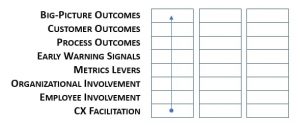
Lead generation best practices continue to evolve and reflect changes in consumer expectations. What was once a quest for quantity has shifted to a more selective pursuit of quality leads that ultimately translate to company revenue. So, how can marketing teams ensure that they are properly measuring performance and propelling a lead generation strategy that delivers revenue impact and sufficient quantities of valuable leads? We turned to Launch Marketing’s executive experts Christa Tuttle, Shawna Boyce and Jeff Raymond for their insights on revenue-driven lead generation marketing.
1. How has lead generation changed over the past several years?
Jeff: The emergence of account-based marketing has certainly affected lead generation. Account-based marketing uses data to narrow the focus of your lead generation work, and figuring out how to properly implement this approach with so much available data is something that marketers are still figuring out.
Shawna: Leads expect more now. Before leads are even willing to have a conversation with your team, they must have sufficient background information. Leads assume they’ll have data and information at their fingertips so they can be well-educated before interacting with your team. They are also expecting more personalized communications. With more data available to marketers, people don’t just want blanket or general content. They want content that they can relate to and work with, and that speaks to their specific needs.
Christa: There’s also a variety of avenues now that leads can be generated through, as well. Previously, lead generation may have just been thought of in terms of information submitted through a website form, but now lead generation is vastly expanding, with channels like remarketing and account-based marketing playing a part. Also, lead generation continues to happen more on the prospect’s or lead’s terms—they’re demanding consumerized experiences and want control of that process. Organizations that recognize this dynamic and give consumers that control over their experience are ultimately going to be more successful.
2. What role does personalization play in attracting leads and driving engagement?
Jeff: Personalization used to be thought of in the early days as simply putting a prospect’s name in the subject line and calling it a day. While this certainly is a good practice for personalization and showing a connection, personalization has evolved into showing that you know your prospects by anticipating their questions and then fully answering those questions within the content you provide.
Christa: Anticipating how potential leads want to be communicated with is also essential. Customers may not prefer being marketed to via email, but instead may want to engage with you on channels like social. Or, maybe there are four major offerings that your company can deliver, but a customer is really only interested in two of them. To understand this, you need to use data or learned information so your marketing can be a better listener to those prospects and/or customers and get as close to a one-to-one marketing relationship as possible, allowing you to attract more leads and drive greater engagement.
Shawna: People interact more frequently when content is personalized. Nurture streams that guide people based on what they’ve downloaded before or what they’ve looked at in the past drive leads through the funnel much faster than if you’re just throwing random pieces of content out there and hoping they stick.
3. What are some commonly overlooked elements of lead generation?
Jeff: Often there’s a failure to concentrate on what’s next for the person in their journey. You want to always anticipate what the next part of their marketing equation is. For example, small things like utilizing the “thank you” page as an opportunity to link to other forms of content that they may be interested in adds value to their customer journey. You also want to make sure your timing is consistent and compliments their journey.
Shawna: Another aspect that may be overlooked is getting leads through the funnel. Even if you’re able to get a large amount of leads in your funnel, you need to focus on what comes after they’re dropped in the funnel so you can keep them there. You also want to make sure you’re thinking about the different mediums of content your leads may prefer. Some may want a more visual medium like a video or infographic, or others may need white papers and blog posts as the way they receive your content. Maybe you’re recycling content or repurposing it, but if it’s not helping the lead generation process goals you established, it’s time to experiment with new forms of content. Learning and knowing this comes from testing and trying out various marketing tactics, and then parsing through the data to come up with strong conclusions that you can act on.
Christa: It’s also essential to create and maintain sales and marketing alignment. Processes need to be established so that both teams understand their role in nurturing the leads that are generated. If sales is communicating with a prospect at a certain stage in their journey, the marketing team needs to know so that they either pause their marketing efforts or they deliver content that compliments the customer’s journey. Sales may want to recycle a lead, meaning they want to pause their sales process, but they don’t want communication to go cold, so then marketing can step back in with their marketing strategy.
4. What role does marketing technology play in the lead generation process?
Jeff: It plays a key role in measuring the performance of your lead generation efforts. Before you jump in, there needs to be an agreement on what your key indicators of performance are and the metrics needed to measure them. Then, you can utilize marketing technology to support these key indicators. Marketing technology is also essential to automation so you’re not tasked with having to manually follow up with certain clients when they interact with or download a particular piece of content. Instead, you can set up rules to trigger your desired action and assign a scoring value to your lead so that everyone on your team and the sales team have a clear view on where that particular lead stands.
Shawna: On top of scoring and automation, marketing technology is also key to the data component we discussed earlier. Marketing technology allows you to track key metrics that inform your marketing process and allow you to gain visibility into how everything is functioning. This way, you can adjust marketing practices as you go and also have the metrics to support why you’re changing up your marketing strategy.
Christa: As valuable as marketing technology is, it becomes far less valuable and a waste of your money if it’s not adopted by all of your team members and clear processes and guidelines aren’t in place for how it’s going be utilized. Just as you want to evaluate your data to ensure you’re achieving desired lead generation goals, you need to regularly assess how your marketing technology is working for your team. Teams may get too comfortable with a particular tool and not realize that it’s missing key features that could be valuable to your lead generation efforts. With so many tools available, it’s essential that you’re continuously evaluating all aspects of your lead generation, from the tools you utilize to the content you’re creating and so much more.
Business & Finance Articles on Business 2 Community
(16)







